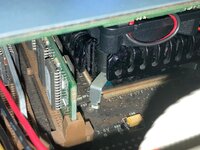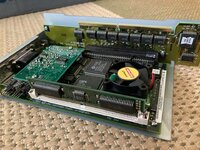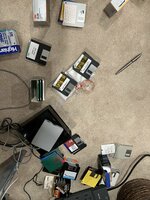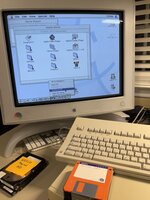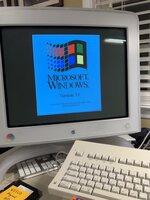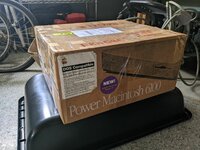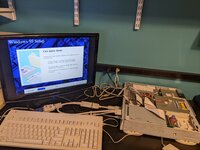I picked up a boxed 6115 a while back and didn’t do anything with it when I first got it other than to open it up and remove the battery, then try to power it up.
Unfortunately, I got no video out on the multisync 15” monitor that came with it. So I set it aside, having other more pressing projects to work on; however I was confused by the weird sequence of dongles needed to connect the monitor. Given the machine looked to have come from a school, and there was a “Apple presentation system” box in with the stuff, I assumed it was for hooking up to a TV or projector.
Well, I finally wrapped up a few of my other projects and pulled the 6115 back out to see if I could clean it up and get it running. I popped the case off (predictably snapping off one of the two tabs holding it down) and decided to remove the weird card that was connected to one of the connectors from the Y shaped adapter.
After removing it, I realized there was a CPU and RAM on the board, and I suspected it might be a dos compatibility card. A quick search using the part number on the card confirmed it was indeed the DOS compatibility card. I never had one, so I don’t know how it works, but I guess the special cable allows for the machine to output the dos side’s video over a single connection to the monitor.
And there’s another connector on there that may be for a joystick?
I still am unable to get the monitor to show anything, but I’m hoping to try a Mac VGA adapter and plug it into a known working monitor tomorrow.
One question I did have: near the back of the board where the external connector is, there’s a smaller board screwed down to it. Any ideas what that extra board is for?

Unfortunately, I got no video out on the multisync 15” monitor that came with it. So I set it aside, having other more pressing projects to work on; however I was confused by the weird sequence of dongles needed to connect the monitor. Given the machine looked to have come from a school, and there was a “Apple presentation system” box in with the stuff, I assumed it was for hooking up to a TV or projector.
Well, I finally wrapped up a few of my other projects and pulled the 6115 back out to see if I could clean it up and get it running. I popped the case off (predictably snapping off one of the two tabs holding it down) and decided to remove the weird card that was connected to one of the connectors from the Y shaped adapter.
After removing it, I realized there was a CPU and RAM on the board, and I suspected it might be a dos compatibility card. A quick search using the part number on the card confirmed it was indeed the DOS compatibility card. I never had one, so I don’t know how it works, but I guess the special cable allows for the machine to output the dos side’s video over a single connection to the monitor.
And there’s another connector on there that may be for a joystick?
I still am unable to get the monitor to show anything, but I’m hoping to try a Mac VGA adapter and plug it into a known working monitor tomorrow.
One question I did have: near the back of the board where the external connector is, there’s a smaller board screwed down to it. Any ideas what that extra board is for?

